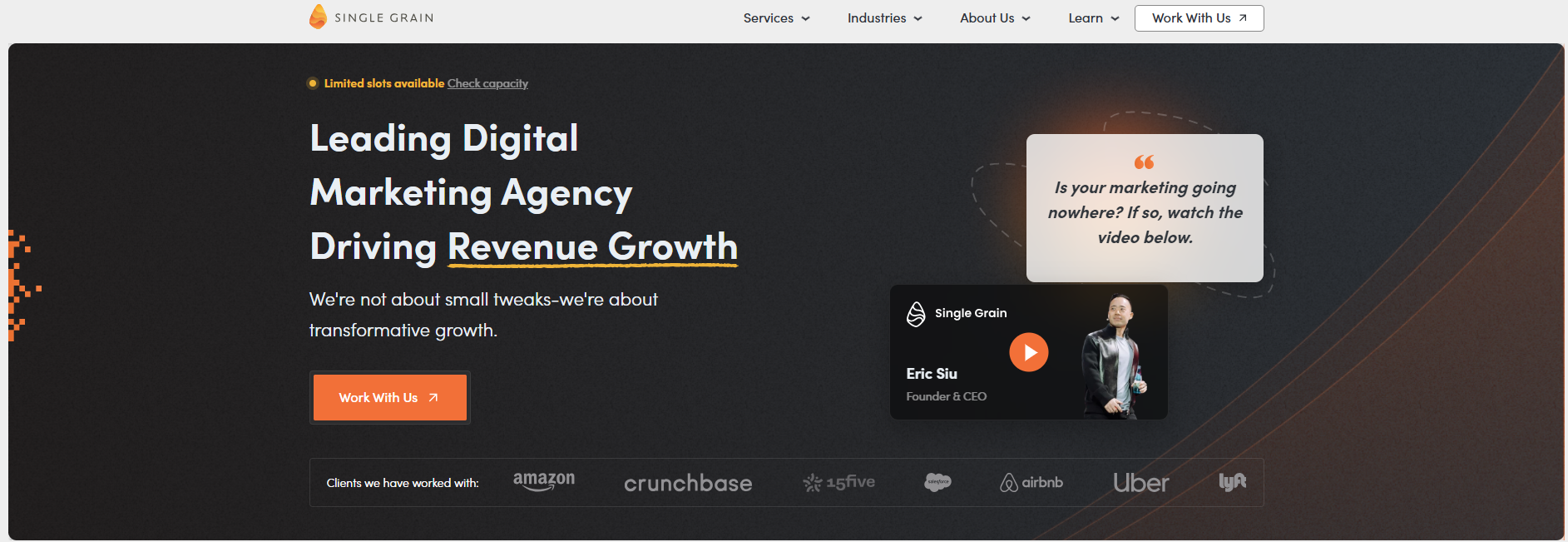How to Build a Cross-Platform PPC Attribution Framework
Cross-platform PPC attribution is the difference between “spend more to hit targets” and “invest smarter to grow profit.” If your board is asking which dollars drove pipeline, ARR, and margin, you need a measurement system that maps every touchpoint to revenue—across Google, LinkedIn, Meta, TikTok, CTV, and beyond.
Enterprise investment signals the moment: the data-analytics market reached $69.54B in 2024 and is projected to grow to $302.01B by 2030 (28.7% CAGR), according to Grand View Research’s data-analytics market report. That surge reflects exactly what CMOs and Marketing Ops leaders are building now—scalable analytics layers capable of multi-touch journeys, privacy-safe identity, and executive-grade reporting that prove PPC’s role in pipeline and revenue.
If you want a second set of eyes on your measurement plan, you can have Single Grain’s analytics team stress-test it. Get a FREE consultation at singlegrain.com.
TABLE OF CONTENTS:
Advanced Cross-Platform PPC Attribution Framework That Ties Spend to Revenue
Winning brands treat attribution as an operating system, not a dashboard. The objective is simple: unify first-party data, enforce tracking governance, apply dual measurement (MTA + MMM) with incrementality testing, and surface pipeline-first KPIs in one source of truth.
Cross-Platform PPC Attribution in Practice: The 5-Layer Stack
- Governance & KPI Alignment: Align finance, sales, and marketing on a common scorecard: pipeline dollars, revenue, ROAS, CAC, LTV, sales velocity, and payback. Define model governance (who owns changes and when).
- Data Foundation: Harden first-party tagging (server-side preferred), disciplined UTMs, offline conversion imports from CRM, and consistent taxonomy for channels, campaigns, and offers. Capture consent and ensure privacy compliance.
- Identity Resolution: Combine deterministic keys (emails, CRM IDs) with privacy-safe probabilistic signals to connect cross-device and cross-session behavior—all within a governed data layer.
- Measurement Engines: Run Multi-Touch Attribution (rules-based or data-driven) for user paths and Marketing Mix Modeling for budget scenarios; validate both with lift tests.
- BI Activation: Pipe unified data into executive dashboards (e.g., Looker, Power BI) with role-based views and alerting for anomaly detection and pacing.

Data Foundation: First-Party, Server-Side, and Identity
Most attribution failures trace back to weak data plumbing. Prioritize server-side tagging to increase data integrity in a cookieless world, deploy conversion APIs for major ad platforms, and enforce naming conventions across campaigns and offers. Combine web analytics with CRM events and product-usage signals so you can connect media to pipeline, expansion, and churn risk—not just last-click leads. A disciplined PPC audit focused on tracking and taxonomy will expose gaps in UTMs, offline conversion mapping, and cross-device stitching before they poison your models.
Activation & Governance: Pipeline-First KPIs
Attribution is not a “report”—it’s a loop. Define decision thresholds (e.g., shift budget when full-path ROAS beats target by 15% for two consecutive weeks), set guardrails for statistical confidence, and publish playbooks for reallocation. Bake in pipeline velocity and stage-to-stage conversion so channel insights translate to sales outcomes, not vanity metrics. Make this the operating rhythm in weekly growth meetings so the org trusts the data.
90-Day Implementation Plan You Can Execute

- Days 1–30: Tracking Hardening & Data Layer — Stand up server-side tagging, enforce UTM standards, sync CRM events to analytics, and validate offline conversion imports. Establish the governed data model.
- Days 31–60: Identity, Models & Experiments — Turn on deterministic matching with CRM IDs, choose initial MTA (e.g., W-shaped or full-path), build a basic MMM, and spin up your first geo or audience holdout test.
- Days 61–90: Dashboards & Ops — Launch executive BI with pipeline-first metrics, set alerting and QA automations, and run your first budget reallocation informed by cross-platform insights, as demonstrated in this multi-channel PPC case study.
Dual-Engine Measurement You Can Defend in the Boardroom
No single model can settle every PPC debate. The answer is a dual-engine system: MTA pinpoints path dynamics across touchpoints, while MMM quantifies diminishing returns and scenario planning. Layer incrementality testing to validate causality and resolve conflicts between platform-reported conversions and ground-truth revenue.
Choosing the Right Multi-Touch Model for Complex Journeys
For complex B2B and high-consideration e-commerce journeys, W-shaped or full-path MTA typically reveals the assists that last-click hides. If your sales process spans months, use account-level rollups and cohort analysis for ABM measurement—and evaluate multi-touch ABM attribution platforms that support long-cycle buying committees. Don’t ignore upper-funnel touchpoints: view-through and content assists often tilt the win rate and shorten cycle time.
When leadership asks about early influence, complement full-path models with a multi-device first-touch perspective to understand which channels reliably create high-intent demand. Use model comparisons as a hypothesis engine, not a scoreboard; your goal is actionable patterns that drive pipeline and profitable growth.
Experimentation and Incrementality to Resolve Conflicts
MTA and MMM will disagree sometimes. That’s your cue to test. Run geo-split, audience holdout, or time-based experiments to quantify true lift for non-clicky channels and brand-led sequences. This is critical for community and content-led traffic where clicks undercount impact—see how to measure Reddit ROI and attribution with privacy-resilient methods in 2025. Document your test design (pre/post windows, minimum detectable effect, safeguards) and feed learnings back into both engines.
Real-World Proof

In one case, Schumacher Custom Homes launched a top-of-funnel Meta video ad strategy. They reported a 42% decrease in CPL and 35 new leads. Klassy Network adopted TikTok into its social media ad campaign. This new approach resulted in $132k in revenue and a 273% higher ROAS. Another example is Superplastic, which utilized both paid social advertising and email marketing for its new product drop. This produced doubled ROAS and a sold-out product line.
Want an objective plan to implement a dual-engine measurement system and custom dashboards your executives will actually use? See how Single Grain’s Data & Analytics team builds multi-touch attribution modeling, ROI tracking, and customer journey analysis tied to revenue. Get a FREE consultation.
Turn Attribution Into Your Growth Engine
If you’re serious about pipeline and profit, build your playbook on cross-platform PPC attribution that unifies data, respects privacy, and powers confident reallocation. Single Grain’s ROI-obsessed approach ties spend to revenue with multi-touch attribution modeling, MMM, and incrementality testing—then operationalizes insights in executive dashboards and weekly growth rituals. The outcome is Growth that matters: lower CAC, faster velocity, and provable ROAS across channels.
Even better, attribution intelligence compounds across marketing. Insights from paid inform Programmatic SEO and our Content Sprout Method, strengthen Moat Marketing defensibility, accelerate Growth Stacking, and create a Marketing Lazarus effect for channels you thought were dead. When your measurement layer is this strong, every play improves.
Ready to see your media decisions through the lens of pipeline, ARR, and margin? Partner with Single Grain’s Data & Analytics team to implement enterprise-grade cross-platform PPC attribution and dashboards your C-suite trusts. Get a FREE consultation.
Frequently Asked Questions
-
How do MTA and MMM work together in cross-platform PPC attribution?
MTA explains how individuals (or accounts) move across touchpoints and which steps tend to accelerate conversion; MMM explains how much budget to place in each channel, given saturation and cross-effects. Paired with incrementality tests, they produce both granular and strategic answers—what to change in-platform this week, and how to reshape budgets next quarter.
-
How do we attribute in cookieless and iOS-restricted environments?
Lean into server-side first-party tagging, consented identity (CRM IDs), and conversion APIs. Use modeled conversions where appropriate, reconcile against offline revenue in your warehouse, and validate with lift tests. This protects measurement integrity while staying privacy-resilient.
-
Which models fit ABM and long sales cycles?
W-shaped or full-path multi-touch models—rolled up at the account level—perform well for ABM because they credit early research, mid-funnel engagement, and opportunity creation. Combine with buying-committee mapping, stage-based pipeline weighting, and model governance that reflects your sales motion. Evaluate solutions purpose-built for ABM when needed.
-
How fast will we see impact, and which KPIs matter most?
Teams typically realize early wins within 60–90 days as tracking, identity, and dashboards go live. Watch full-path ROAS, pipeline-to-spend ratio, CAC payback, velocity by segment, and win-rate changes tied to specific sequence patterns. Use these signals to drive weekly reallocations and quarterly planning.
-
How do we measure upper-funnel and community channels?
Rely on a blend of modeled conversions, view-through analysis, MMM, and controlled experiments (geo, audience, or time-based). Instrument brand lifts, ad recall, and assisted pipeline contribution; reconcile with offline revenue and repeat these tests quarterly to maintain confidence.




